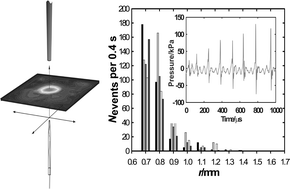Experimental and theoretical characterisation of sonochemical cells.
Part 2:† cell disruptors (Ultrasonic horns) and cavity cluster collapse
Abstract
Cavitation theory is used to predict the acoustic pressure at the boundary of the inertial/non inertial threshold for a range of bubble sizes. The sound field generated from a commonly employed sonoelectrochemical cell is modelled. The model is tested with a calibrated hydrophone far from the transducer to avoid spatial averaging. This allows the model to provide the absolute pressure amplitude as a function of axial distance from the source. An electrochemical technique for detecting both inertial and non-inertial cavitation within the solution is employed. This technique uses a dual microelectrode to map the boundary between the regions where inertial cavitation occurs (associated with surface erosion), and where it does not. This zone occurs close to the transducer for the microelectrode employed (<1.5 mm). Further characterisation of the inertial cavitation zone is achieved by imaging of multibubble sonoluminescence (MBSL). The pressures at the boundary between inertial and non inertial cavitation that are determined from the electrochemical and imaging experiments are compared to a sound field model and cavitation theory. Qualitative arguments for the invasive nature of the electrode into the sound field are proposed. Evidence for cavity cluster collapse and shock wave emission is presented and discussed in relation to luminescence, the electrochemical experiments and cavitation theory.


 Please wait while we load your content...
Please wait while we load your content...